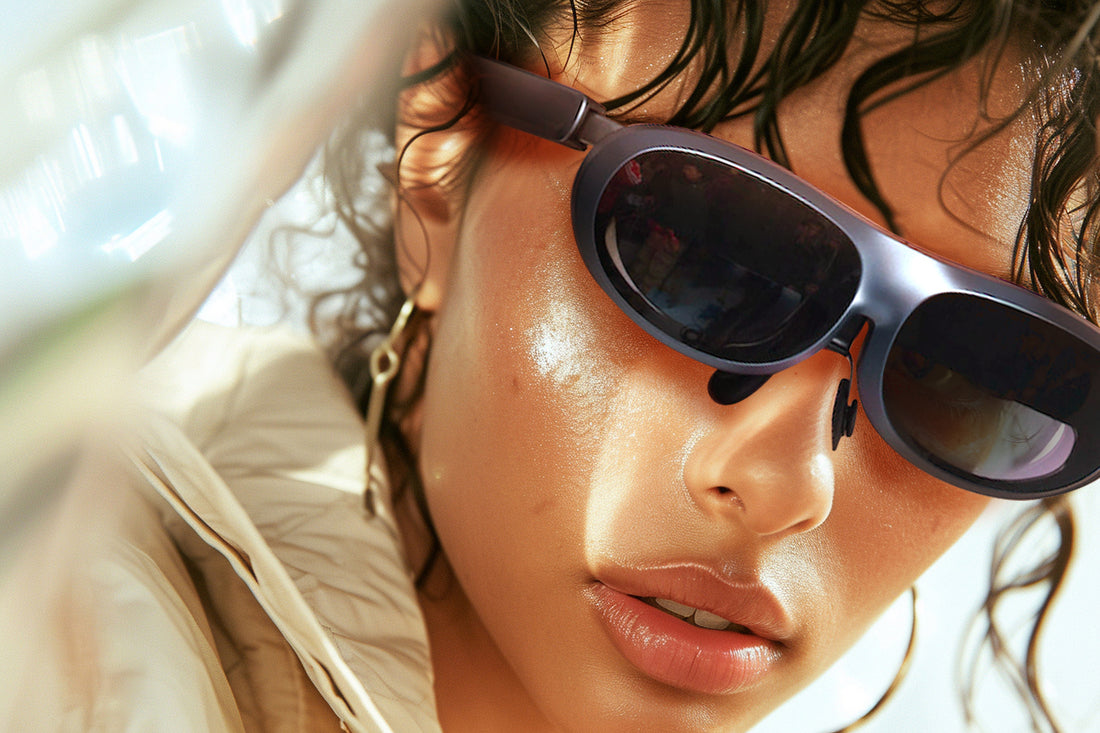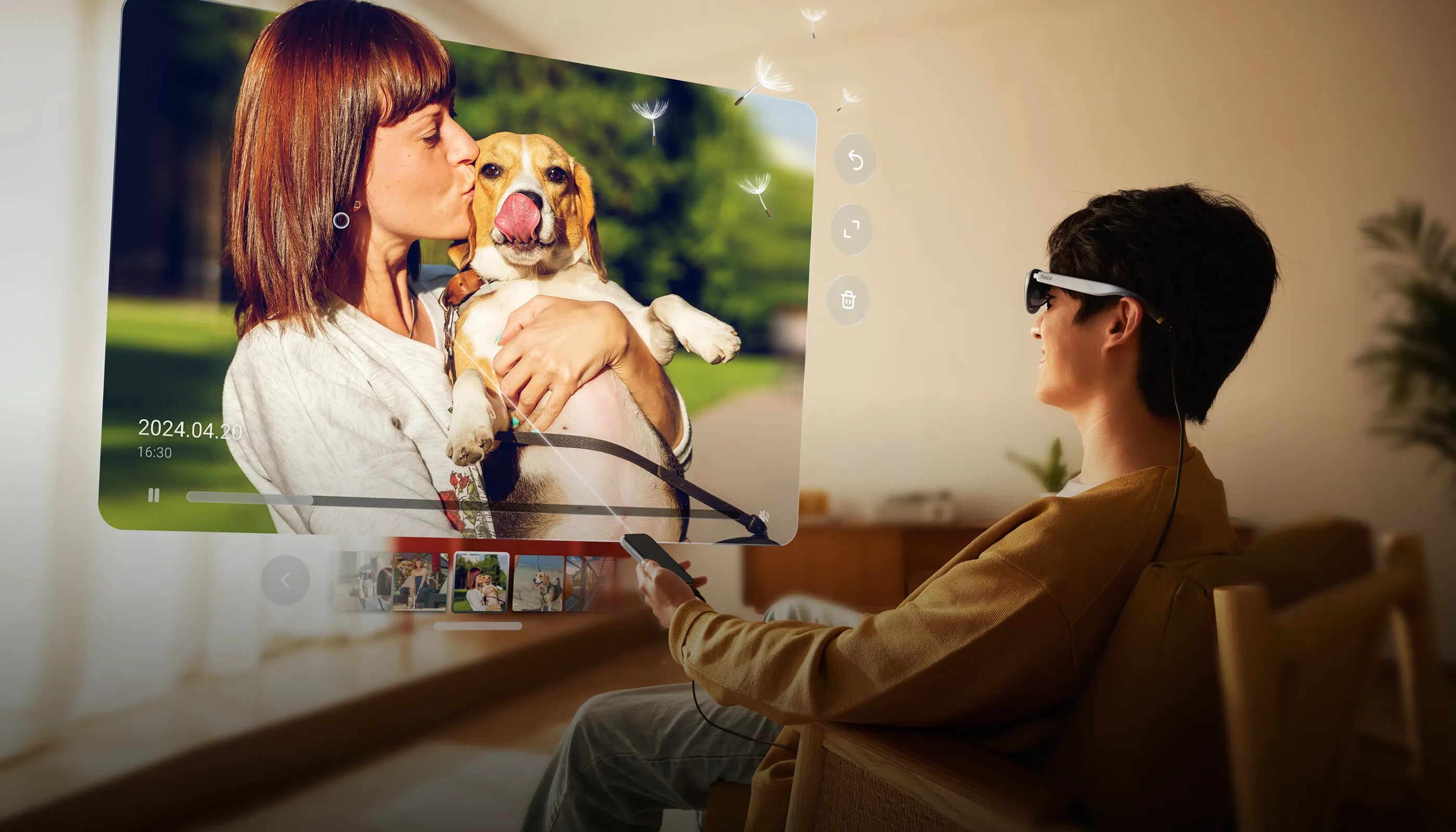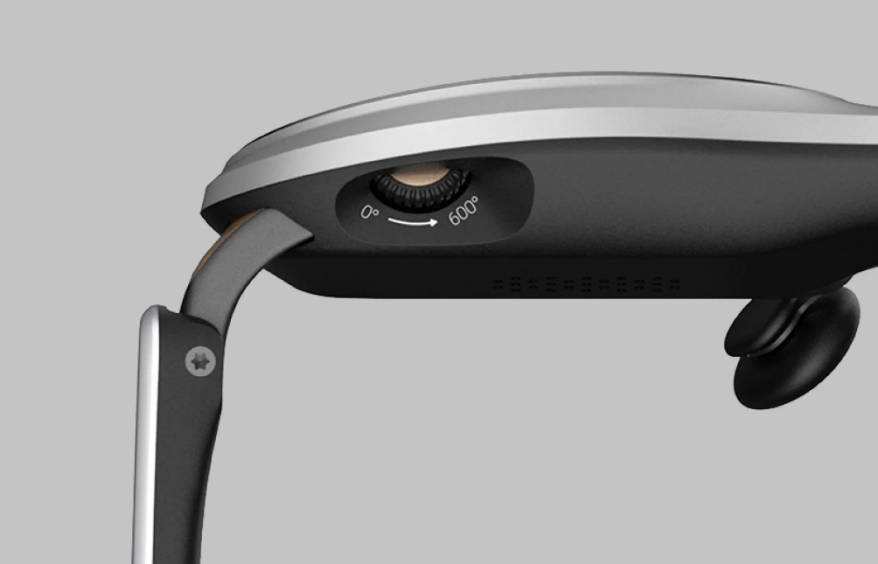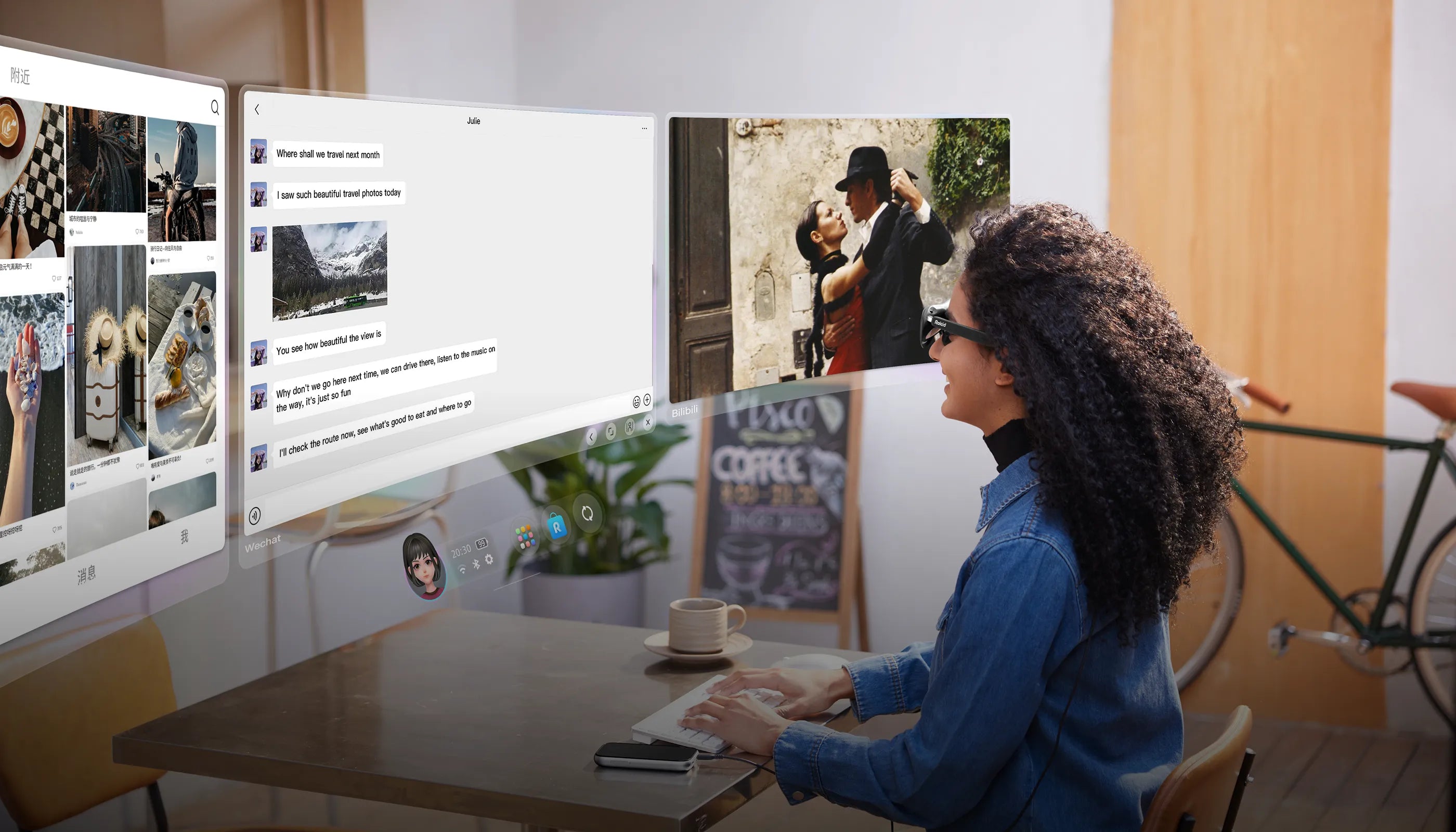
Welcome to the cutting edge of audio technology, where the lines between sight and sound blur into a seamless, immersive experience. We're talking about headphone glasses, a revolutionary innovation that combines high-fidelity audio with visual displays embedded into the lenses, ushering in a new era of entertainment, communication, and digital interaction.
This comprehensive guide delves deep into the world of headphone glasses, exploring their evolution, design, features, functionalities, and potential within the broader technological landscape. Whether you're a tech enthusiast, an audiophile, or simply curious about the future, this exploration will equip you with the knowledge to navigate the exciting possibilities of headphone glasses.
Definition and Overview: What are Headphone Glasses?
Headphone glasses, also known as smart glasses with audio, are wearable devices that integrate high-quality speakers or open-ear audio systems with visual displays embedded into the lenses. This unique combination allows users to enjoy immersive audio experiences while simultaneously accessing visual information, notifications, or even engaging with augmented reality (AR) content.
Imagine listening to music while seeing lyrics or album art displayed right before your eyes. Picture attending a virtual meeting where you can see your colleagues in a lifelike, holographic presentation. These are just a glimpse of the transformative potential held by headphone glasses.
Evolution of Headphone Glasses: From Idea to Reality
The concept of headphone glasses has been around for decades, appearing in science fiction films and futuristic predictions. However, technological limitations and high development costs hampered their progress for a long time.
The turning point came in the late 2010s, with advancements in miniaturization, display technology, and wireless connectivity. Leading tech companies and startups began investing heavily in research and development, leading to the emergence of commercially available headphone glasses in recent years.
Today, the market is witnessing a rapid evolution with new models and features constantly being introduced. This rapid progress suggests that headphone glasses are poised to become a game-changer in the audio and visual technology landscape.
Design and Technology of Headphone Glasses: Unpacking the Magic
Headphone glasses are marvels of engineering, meticulously designed to deliver superior audio and visual experiences in a compact and comfortable form factor. Let's explore some of the key technological components:
Innovative Features:
- Micro displays: These miniaturized screens embedded in the lenses can project text, images, videos, or even holographic content directly onto the user's field of view.
- Open-ear or bone conduction audio: Different approaches are used to deliver sound. Open-ear systems project sound towards the user's ears without blocking the surrounding environment, while bone conduction transmits vibrations directly to the inner ear bones.
- Head tracking and gesture control: Advanced sensors allow the glasses to track head movements and respond to gestures, enabling intuitive interaction with the visual displays.
- Voice assistants and AI integration: Integrating with voice assistants like Google Assistant or Amazon Alexa allows for hands-free control and interaction with various applications.
Integration of Audio and Visual Technology:
The true magic of headphone glasses lies in the seamless integration of audio and visual elements. This synergy opens up a world of possibilities:
- Immersive entertainment: Imagine watching movies or playing games where the sound perfectly blends with the visuals, creating a truly captivating experience.
- Enhanced communication: Video calls and virtual meetings can feel more natural and engaging with eye contact and shared visual elements.
- Augmented reality applications: Overlaying digital information onto the real world unlocks a plethora of use cases, from navigation and information access to interactive gaming and educational experiences.
Comparing Headphone Glasses with Traditional Headphones: A Shifting Paradigm
Headphone glasses offer several distinct advantages over traditional headphones:
User Experience Comparison:
| Feature | Traditional Headphones | Headphone Glasses |
|---|---|---|
| Audio experience | Limited to audio | Immersive audio & visual |
| Situational awareness | Can isolate users | Increased awareness |
| Comfort | May cause discomfort during extended wear | Designed for comfort |
Beyond the technical aspects, headphone glasses offer a paradigm shift:
- Enhanced engagement: Visual elements enrich the audio experience, making it more interactive and captivating.
- Multitasking capabilities: Users can access visual information and even interact with apps without taking off the glasses, improving multitasking efficiency.
- Increased situational awareness: Open-ear audio systems allow users to stay aware of their surroundings, enhancing safety and comfort compared to closed-back headphones.
Types of Headphone Glasses: Exploring the Variety
The headphone glasses market is diverse, offering various models catering to different needs and budgets. Some popular types include:
Various Models and Brands:
- Sports and fitness glasses: Designed for durability and sweat resistance, often featuring open-ear audio for situational awareness. Popular brands include Bose Frames Tempo and AfterShokz Aeropex.
- Fashion-focused glasses: Blending style with technology, these glasses offer a sleek and discreet design for everyday use. Brands like Gucci and Oakley are entering this space with their offerings.
- Gaming glasses: Optimized for immersive gaming experiences, featuring high-resolution displays, low latency, and compatibility with gaming platforms. Check out Rokid Air glasses specifically designed for gamers, offering an exceptional AR gaming experience: glasses that display video: https://global.rokid.com/.
- Enterprise glasses: Geared towards professional applications, these glasses prioritize functionality and security, often featuring voice control and compatibility with enterprise software. Microsoft HoloLens and Vuzix M400 are popular examples.
Specific Use Cases for Different Types:
- Commuting: Stay entertained with music or podcasts while staying aware of your surroundings with open-ear audio glasses.
- Workouts: Track your fitness data, listen to motivational music, and even see coaching cues through AR overlays with sports glasses.
- Gaming: Immerse yourself in virtual worlds with high-resolution visuals and responsive audio in gaming glasses like Rokid Air (link above).
- Travel: Translate languages in real-time, get directions, and access information hands-free with travel-friendly glasses.
- Presentations: Deliver dynamic presentations with interactive elements and visual aids using enterprise glasses.
Choosing the right type of headphone glasses depends on your individual needs and preferences. Consider factors like budget, desired features, comfort, and intended use case when making your decision.
Audio Quality in Headphone Glasses: Striking the Right Chord
Audio quality is paramount for any audio device, and headphone glasses are no exception. Here's what to consider:
Sound Technology and Performance:
- Open-ear vs. bone conduction: Open-ear systems offer a natural listening experience but may leak sound. Bone conduction delivers private audio but may lack bass response.
- Audio codecs and processing: Look for glasses that support high-quality codecs like aptX or LDAC for superior sound reproduction.
- Equalizer and customization options: The ability to adjust the sound signature to your preferences is crucial for a personalized experience.
Comparison with High-End Headphones:
While high-end headphones may still offer superior audio fidelity in terms of pure sound quality, headphone glasses excel in creating an immersive and interactive audio experience. The integration of visual elements and spatial audio capabilities opens up new possibilities for sound enjoyment.
Visual Aspects of Headphone Glasses: Seeing is Believing
The visual component plays a vital role in the overall experience of headphone glasses. Here's what to consider:
Lens Technology and Options:
- Micro LED, OLED, or LCD displays: Each technology offers different advantages in terms of brightness, resolution, and power consumption.
- Field of view (FOV): A wider FOV creates a more immersive experience, but it can also be more power-hungry.
- Adjustable focus: The ability to adjust the focus ensures a clear and comfortable viewing experience for users with different prescriptions.
Style and Aesthetics:
Headphone glasses are available in a variety of styles, from sporty and rugged to sleek and sophisticated. Choose a pair that complements your personal style and reflects your individuality.
Looking for stylish and powerful smart glasses? Explore Rokid's latest collection: shop smart glasses: https://global.rokid.com/products/rokid-max.
Connectivity and Compatibility: Seamless Integration
Seamless connectivity is essential for a smooth user experience. Here's what to look for:
Wireless Technology in Headphone Glasses:
- Bluetooth: The most common connection standard, offering good compatibility with various devices.
- Wi-Fi: Enables access to online content and streaming services directly on the glasses.
Compatibility with Devices and Platforms:
- Ensure the glasses are compatible with your smartphone, computer, gaming console, or other devices you plan to use them with.
- Check for software updates and app availability to ensure you have access to the latest features and functionalities.
Rokid glasses, like Rokid Air, offer seamless compatibility with various devices and platforms, making them a versatile choice for all your needs.
Looking for the best AR glasses for your needs? Check out Rokid's offerings and discover the perfect match: [best ar glasses](<invalid URL removed>
Applications of Headphone Glasses:
Beyond entertainment, headphone glasses unlock a plethora of applications across various aspects of life:
Everyday Use and Lifestyle:
- Navigation and wayfinding: See turn-by-turn directions overlaid on your real-world view, ensuring you never get lost again.
- Fitness tracking and coaching: Receive real-time feedback and coaching cues through AR overlays, maximizing your workouts and achieving your fitness goals.
- Translation and language learning: See translated text in real-time or use language learning apps with AR overlays, breaking down language barriers and fostering communication.
- Shopping and information access: View product information, compare prices, and access reviews instantly while browsing in stores, making informed purchase decisions.
Professional and Gaming Use:
- Remote collaboration and presentations: Deliver dynamic presentations with interactive elements and share virtual workspaces with colleagues remotely, enhancing collaboration and engagement.
- Industrial applications: Access maintenance manuals, view schematics, and receive real-time guidance through AR overlays, increasing efficiency and safety in industrial settings.
- Immersive gaming: Experience breathtaking visuals and spatial audio that transport you into the heart of the game, blurring the lines between reality and virtual worlds. Check out Rokid Air, designed specifically for gamers, for an unparalleled AR gaming experience: best ar glasses: https://global.rokid.com/blogs/articles/the-best-ar-glasses-for-steam-deck-enhancing-your-gaming-experience.
User Comfort and Ergonomics:
Design for Comfort:
- Lightweight and well-balanced design minimizes fatigue and ensures comfortable extended wear.
- Adjustable nose pads and temples provide a secure and personalized fit.
- Breathable materials prevent overheating and discomfort.
Long-term Wear and Health Impacts:
- Look for glasses that comply with safety regulations and emit low levels of blue light to minimize potential eye strain.
- Take regular breaks to avoid eye fatigue and ensure proper hygiene practices to maintain good eye health.
Battery Life and Power Management:
Battery Technology in Headphone Glasses:
- Battery capacity and efficiency vary depending on the model and display technology.
- Look for glasses with efficient power management features to extend battery life.
Tips for Optimizing Battery Life:
- Adjust display brightness and volume levels.
- Turn off features you're not using.
- Utilize quick charging options when available.
Durability and Maintenance:
Build Quality and Durability Factors:
- Look for glasses made from high-quality materials that can withstand everyday wear and tear.
- Water resistance and dustproof features are beneficial for active lifestyles.
Maintenance and Care Tips:
- Follow the manufacturer's cleaning instructions to avoid damaging the delicate components.
- Store your glasses in a protective case when not in use.
Customization and Personalization:
Personalization Options:
- Adjustable audio profiles and EQ settings.
- Custom lenses or prescription inserts.
- Changeable frames or temple styles.
Custom Fit and Accessories:
- Some models offer adjustable straps or temple tips for a personalized fit.
- Explore accessories like prescription lenses or sunglass overlays to tailor the glasses to your needs.
Price Range and Value for Money:
Cost Analysis:
- Compare features and functionalities across different models within your budget.
- Consider the long-term value proposition, including potential use cases and future-proofing capabilities.
Comparing Value with Traditional Audio Devices:
While headphone glasses may have a higher initial cost than traditional headphones, they offer a unique blend of audio and visual experiences, increased situational awareness, and potential for hands-free interaction. Weigh the added value against the price tag to determine if they're the right investment for you.
Consumer Reviews and Feedback:
Overview of User Reviews:
- Read reviews from various sources to get a well-rounded perspective.
- Pay attention to recurring themes in both positive and negative feedback.
Analysis of Feedback Trends:
- Identify common praises and concerns regarding comfort, audio quality, features, and value.
- Use this information to make an informed decision based on your priorities.
Challenges and Limitations:
Technical Challenges:
- Battery life, miniaturization, and display technology are areas of ongoing development.
- Balancing processing power and heat dissipation remains a challenge.
Market Acceptance and Limitations:
- Cost, user adoption, and content availability are currently limiting factors.
- Addressing privacy concerns and ethical considerations is crucial for wider adoption.
The Future of Headphone Glasses: A Glimpse into Tomorrow's Vision
The lines between science fiction and reality continue to blur as headphone glasses evolve at an exhilarating pace. Let's delve deeper into the exciting developments shaping their future:
Technological Advancements:
- Micro displays are shrinking and getting sharper: Imagine high-resolution, near-eye displays offering crystal-clear visuals that seamlessly blend with the real world. MicroLED and OLED advancements promise vibrant colors, deeper blacks, and wider viewing angles, enhancing immersion and reducing eye strain.
- Battery breakthroughs unlock extended play: Imagine using your headphone glasses for hours on end without worrying about running out of power. Solid-state batteries and improved power management systems are on the horizon, offering significant leaps in battery life, freeing users from the limitations of current models.
- AI integration personalizes the experience: Imagine headphone glasses that anticipate your needs and preferences. AI-powered features like adaptive noise cancellation, dynamic content adjustment, and real-time translation will personalize the experience, making them even more intuitive and user-friendly.
Brain-Computer Interfaces (BCIs): Merging Minds and Machines:
The future might hold the integration of BCIs, enabling direct communication between your brain and the headphone glasses. Imagine controlling menus, manipulating virtual objects, or even experiencing augmented reality through thought alone. While still in its early stages, BCI holds immense potential to revolutionize human-computer interaction and push the boundaries of what's possible with headphone glasses.
Predictions and Market Growth: A Thriving Landscape:
Industry experts predict significant market growth in the coming years. Falling costs, wider content availability, and increasing user adoption will fuel this expansion. Headphone glasses are expected to transcend niche markets and become mainstream wearables, integrated into various aspects of our lives.
- Gaming: Imagine fully immersive worlds where you don't just play the game, you live it. Advanced BCI integration could create unparalleled levels of control and sensory feedback, blurring the lines between reality and the virtual world.
- Education and Training: Imagine interactive learning experiences where complex concepts come to life through AR overlays. Students could dissect virtual models in biology class, explore historical events in 3D, or practice surgical procedures in a risk-free environment.
- Healthcare: Imagine remote consultations where doctors can examine patients virtually, overlaying medical data onto the patient's body in real-time. AR-guided surgery could improve precision and efficiency, while therapeutic applications could leverage the immersive power of headphone glasses for pain management and rehabilitation.
The possibilities are truly endless. As technology continues to evolve, headphone glasses have the potential to redefine the way we interact with information, entertainment, and the world around us. The future is bright for this transformative technology, and it's an exciting time to be a part of the journey.
Remember, this is just a glimpse into the vast potential of headphone glasses. As research and development continue, we can expect even more groundbreaking advancements that will shape the future of this revolutionary technology.
Buying Guide for Headphone Glasses: Demystifying Your Perfect Pair
Navigating the exciting yet complex world of headphone glasses can feel daunting. This comprehensive guide empowers you to make informed decisions and find the perfect pair that aligns with your needs and preferences.
Factors to Consider Before Purchase:
- Intended Use: Identify your primary use case (entertainment, gaming, productivity, etc.) to prioritize relevant features.
- Budget: Determine your comfortable spending range and explore options that offer the most value within your budget.
- Comfort and Ergonomics: Prioritize lightweight design, adjustable features, and breathable materials for extended wearability.
- Audio Quality: Evaluate sound signature, noise cancellation, and compatibility with desired codecs for an immersive audio experience.
- Visual Capabilities: Consider display resolution, field of view, and compatibility with prescription lenses if needed.
- Connectivity and Compatibility: Ensure seamless pairing with your devices and desired platforms.
- Battery Life: Assess battery capacity and available power-saving features to match your usage patterns.
- Durability and Warranty: Opt for well-built models with adequate warranty coverage for peace of mind.
Recommended Brands and Models:
- Rokid: Renowned for its diverse offerings, including Rokid Air for gamers and Rokid Max for a large virtual screen experience.
- Microsoft: Focuses on enterprise applications with models like HoloLens 2, ideal for professionals seeking AR integration.
- Magic Leap: Pioneering in advanced AR technology, Magic Leap 2 offers powerful features for developers and creators.
Headphone Glasses FAQs:
- Q: Are they safe for my eyes? A: Reputable brands adhere to safety regulations and offer low blue light emission. However, take regular breaks and follow good eye care practices.
- Q: Can I wear them with glasses? A: Some models offer prescription inserts or adjustable nose pads for compatibility with eyeglasses.
- Q: Will they replace traditional headphones? A: Both have their strengths. Headphone glasses offer unique immersive experiences, while traditional headphones may excel in portability and affordability.
Remember, this is just a starting point. Conduct further research, explore online reviews, and consider trying different models before making your final decision.
The future of headphone glasses is brimming with potential, and choosing the right pair today opens doors to a world of immersive experiences and innovative possibilities. By considering your needs and exploring the available options, you're well on your way to unlocking the magic of this groundbreaking technology.
I hope this comprehensive guide empowers you to find the perfect pair of headphone glasses and embark on your own unique journey into the future of audio and visual immersion!



